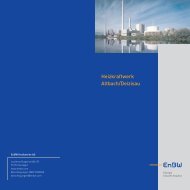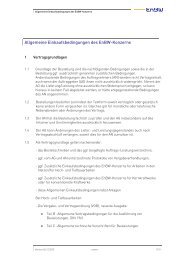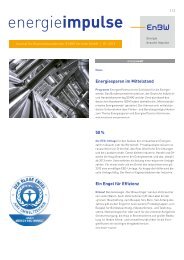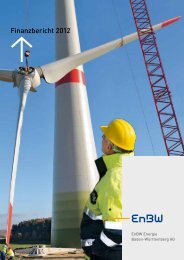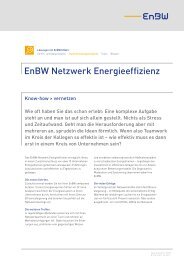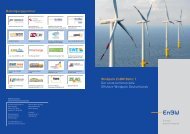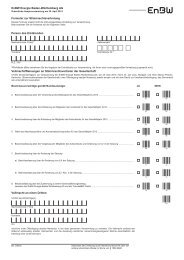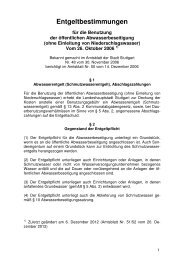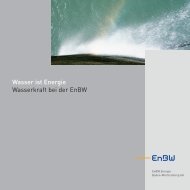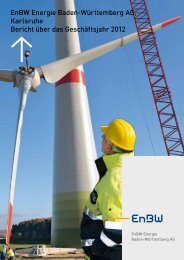Environmental Report 2000 - EnBW
Environmental Report 2000 - EnBW
Environmental Report 2000 - EnBW
Create successful ePaper yourself
Turn your PDF publications into a flip-book with our unique Google optimized e-Paper software.
Further Information<br />
What goes into the production of one kilowatt hour<br />
of electricity<br />
Electricity generation is a highly complex and elaborate process. But as ecological findings<br />
show, the industry’s impact on the environment can now be kept to a minimum thanks to<br />
modern, state-of-the-art technology.<br />
We can trace the flow of electricity<br />
backwards from the plug in the living<br />
room over the wire that leads to the<br />
house connection line which leads to<br />
the local transformer. From there it<br />
goes via subterranean or overhead<br />
cable to the transformer station and<br />
from there via medium-voltage networks,<br />
substations with transformers,<br />
switching systems and converters<br />
and high-voltage lines all the way<br />
back to the power plant.<br />
In our group this means mainly nuclear<br />
power plants, coal- and gas-fired plants<br />
and hydroelectric generating stations.<br />
The electricity which reaches the end<br />
user through the network is produced<br />
here by the action of turbines in the<br />
generator. We produce the heat and<br />
steam which is essential for this process<br />
by splitting the uranium atom or<br />
by burning coal and gas or by harnessing<br />
the power of moving water to<br />
operate the turbines.<br />
“Ingredients” for electricity<br />
generation<br />
The nuclear fuel uranium is mined<br />
throughout the world from uraniumrich<br />
rock, then treated, concentrated,<br />
inserted in tablet form into fuel rods<br />
and transported to the nuclear power<br />
plant.<br />
44<br />
Coal, oil and gas are million-year old<br />
fossil remains of plants and small<br />
animals, transformed and preserved<br />
in pockets in the earth’s crust. Coal is<br />
produced in many regions of the<br />
world. We may get it from Australia,<br />
South Africa or Columbia where huge<br />
bucket wheel excavators extract it<br />
from open cast mines. It is then<br />
shipped to Rotterdam and from there<br />
transported to Germany.<br />
Two million tonnes of coal<br />
in one year<br />
Last year our plants at Heilbronn and<br />
Karlsruhe consumed around two million<br />
tonnes of coal, producing waste<br />
gases such as carbon dioxide, sulphur<br />
dioxide, nitrogen oxide as well as<br />
dust. Highly efficient units can filter<br />
the majority of the pollutants out of<br />
the flue gases with the exception of<br />
carbon dioxide, the basic by-product<br />
of every combustion process. But the<br />
filtered products can themselves have<br />
new negative environmental impacts<br />
if they have to be stored. This is why<br />
we process the gypsum and fly ash<br />
we gain from the filters into materials<br />
for the construction industry. .<br />
Ecological stock-taking<br />
An “eco-breakdown” of our electricity<br />
generating activities provides the following<br />
picture.<br />
For one kilowatt hour of electricity –<br />
the equivalent, say, of one hour spent<br />
using the vacuum cleaner – we require<br />
(based on our <strong>2000</strong> energy mix) 0.001<br />
grams of uranium, 76 grams of coal,<br />
1 gram of natural gas and 1 gram of<br />
heating oil as well as 2 grams of<br />
limestone.<br />
The production of one kilowatt hour<br />
of electricity based on this energy mix<br />
involves approx. 0.005 grams of radioactive<br />
waste material, 225 grams of<br />
carbon dioxide, 0.20 grams of sulphur<br />
dioxide, 0.16 grams of nitrogen oxide,<br />
and 0.005 grams of dust, 0.7 grams<br />
of waste material, as well as 3 grams<br />
of gypsum and 8 grams of fly ash for<br />
the cement industry.<br />
Minimal environmental impact<br />
With the advanced technology we<br />
have installed in our power plants to<br />
protect the environment, we ensure<br />
that environmental impact is kept to a<br />
strict minimum. Even if we take preand<br />
post production processes into<br />
account, the overall picture remains<br />
substantially the same. And the large<br />
quota of nuclear and hydroelectric<br />
power we produce means that our<br />
specific CO2 emission levels are also<br />
relatively low: with 225 grams per<br />
kilowatt hour, we have only reached<br />
about 40% of the national average.<br />
Natural gas is an environmentallyfriendly<br />
fuel for both domestic use<br />
and power stations. When burned,<br />
it only produces little CO 2.<br />
However, reserves are somewhat<br />
limited, and it is thus inclined to be<br />
relatively expensive.



